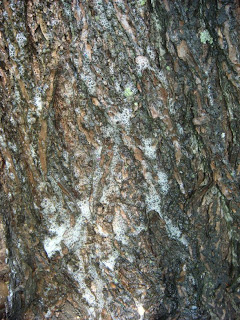Nearby Nature: What in the world are wolf trees?
 |
| This red oak wolf tree is a great place to hang out! |
One of our favorite places to explore is a small strip of woods in between an apartment complex, and an abandoned pasture. Earlier I wrote about some cool mushrooms we found in there. Some of the mushrooms were growing on dropped branches from a huge red oak tree I referred to as a 'wolf tree'.
Look at out the trees you have growing in your yard, on your street, or in a nearby park. Trees that grow out in the open, on their own, not close to other trees grow in their perfect form. These lollipop shaped trees do not compete with other trees for sunlight, soil nutrients, or water—so they grow perfectly with big canopies and branches reaching way out from the trunk.
If you find the same kind of tree that is growing on your lawn growing somewhere in the woods, you will see a very different shaped tree. Forest trees grow close together and they are competing for sunlight, soil nutrients, and water. These forest trees are reaching, reaching, reaching their branches high up into the sky to try and get the sunlight they need to grow.
Wolf trees are trees that grew out in the open for a very long time so they are shaped like the trees you see growing out in the open yet they are now surrounded by smaller trees growing in wooded areas. Wolf trees are clues to how the land where they grow has been used, wolf trees in Vermont are at least 150 years old.
Another reason to clear trees at the time was the big economic driver from the Merino wool market in the early 1800’s. Sheep farming requires pastureland, and forests were cleared to provide space for this lucrative industry.
 As these early European Vermont settlers cleared land, they left the largest trees in pastures to provide shade and food for livestock. Later as these hill farms were abandoned, new forest trees sprung up around the wolf trees, which is why we find them today in the woods surrounded by smaller trees often of different species.
As these early European Vermont settlers cleared land, they left the largest trees in pastures to provide shade and food for livestock. Later as these hill farms were abandoned, new forest trees sprung up around the wolf trees, which is why we find them today in the woods surrounded by smaller trees often of different species. As the forests in Vermont grew up around these big trees, early foresters in the second half of the 20th century were preparing to make the first cutting in these woodlands. The thoughts of foresters at the time was these very large trees should be cut because they were preying on forest resources and out-competing the new trees growing there. Foresters at the time created the analogy of a wolf preying on forest resources and the name stuck for generations. Now we know these large wolf trees have great value as wildlife habitat and they do not cause strain on forest resources.
The wolf tree we explore and play on is a huge red oak, with gigantic branches reaching straight out. Some of these large branches have died and dropped off, and some are hanging on. It is common for lower branches on wolf trees to die and drop as they become shaded out by forest trees growing around them. I understand why a former landowner kept this large red oak, it still grows thousands of acorns, which are some of the most nutrient rich nuts available in the woods. We see evidence that our favorite wolf tree is popular with local wildlife each time we visit.
What cool, big trees do you have growing nearby your home? What animal signs have you seen near your favorite tree?

.jpg)
.jpg)
Comments
Post a Comment
Feel free to let us know what you think.